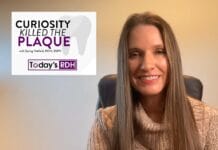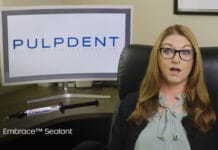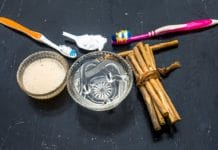Ask any dental professional what the hardest substance in the human body is, and they will quickly answer that question. In fact, I hear this question often on radio and TV trivia. While the common population may not be aware of it, dental professionals know this answer without fail: The hardest substance of the human body is tooth enamel.
Enamel is the outermost layer of the human tooth (also found on the teeth of dogs and cats) and is comprised of mostly hydroxyapatite (HA). However, enamel also contains 4% organic material: magnesium, sodium, fluoride, carbonate, and water.2 Enamel is the outer protective layer for the softer layers of the tooth, dentin, and the pulp.
Being compromised of approximately 96% hydroxyapatite, this organic material is vital to the strength of tooth enamel.2 Hydroxyapatite is also found in saliva, which helps to remineralize and repair the tooth enamel, acting as building blocks. Hydroxyapatite is the bioavailable form of calcium used by our bodies to rigidify and strengthen the bone and the hard structures of our teeth.1
Nano-hydroxyapatite (nano-HA) is the synthetic version of this valuable substance.
Beginning of Hydroxyapatite Toothpaste
The medical application of hydroxyapatite began with NASA. While in microgravity, the human body experiences many changes. One change is the loss of bone since the weight that bones support is reduced to almost zero, nor are they subjected to the same stresses in space. NASA sought ways to replace lost minerals in the bone and teeth during space duration and proposed incorporating brushite (calcium, hydrogen, phosphate, and water) in a gel solution to formulate hydroxyapatite in 1974.
Sangi Co., LTD, a Japanese-based company, was the first to express an interest in hydroxyapatite reproduction and purchased the rights in 1970 from NASA.2 In 1978, they proposed launching a synthetic nano-hydroxyapatite in toothpaste to help repair tooth enamel.
After many trials and errors, Sangi worked diligently with researchers, young scientists, and a manufacturer to successfully create a toothpaste. The result was the world’s first hydroxyapatite-containing toothpaste, Apadent, launched in 1980, followed by a second brand, Apagard, in 1985.4 It wasn’t until 1993 that this formulation was officially recognized as an anti-caries agent and deemed “medical hydroxyapatite” in Japan.3
In 2017, the first nano-hydroxyapatite toothpaste in the US was released. Today, oral care products containing hydroxyapatite exist in some form (including micron-sized and abrasive variants) in more than 200 brands in over 70 countries worldwide.
Benefits Not Offered by Fluoride
Fluoride, a naturally occurring element, has been used for decades to help in the prevention of tooth decay. The Centers for Disease Control and Prevention (CDC) named community water fluoridation one of 10 great public health achievements of the 20th century. Water fluoridation alone reduces dental decay by about 20% to 40% of children and adults.4 Fluoride is the main ingredient in most toothpaste and can be administered in the dental office as prescription strength.
However, fluoride is not rich in calcium and phosphate, two important components in hydroxyapatite, thus making it just as important as fluoride and an excellent adjunct in the prevention of dental decay. Nano-hydroxyapatite shows a high similarity to the mineralization phase of human teeth and bones. Its high biocompatibility makes it favorable for younger children who have not mastered the art of spitting.5
Particles Reconstruct Bone
Due to the size of nano-hydroxyapatite particles, it has a strong ability to bond with proteins by increasing the surface size and binding with fragments of plaque and bacteria when contained in toothpaste.2 In addition, nano-hydroxyapatite also acts as filler because it repairs small holes and depressions on the enamel surface, a function enhanced by the small size of the particles that compose it.2
Nano-HA is also used to help reconstruct periodontal bone defects, such as filling bone defects after a cystectomy and apicoectomies. It is also used to increase the thickness of atrophic alveolar ridges. The chemical makeup of Nano-HA is very similar to bone minerals, thus making it a very attractive candidate in bone grafts of sorts. Nano-hydroxyapatite is also used outside of dentistry in the field of orthopedics to assist in bone regeneration.7
One in situ study showed that a nano-HA toothpaste remineralized initial enamel caries and inhibited enamel demineralization as effective as toothpaste with 500 ppm fluoride, and microradiographic images showed that the nano-HA toothpaste also remineralized deeper enamel layers.5 Clinical studies validate the efficacy of nano-hydroxyapatite; however, one study comparing the results of nano-HA and fluoride showed there were no significant differences and that both equally remineralize tooth enamel.6
Nano-hydroxyapatite is a great substitute for fluoride for those seeking alternative methods to reduce carious lesions, such as in smaller children or those who simply want to avoid fluoride. While I do not believe eliminating fluoride or permanently replacing it with nano-HA is ideal, I do, however, feel it is a solid alternative or adjunct to support enamel remineralization. As this material grows in popularity, I feel confident that it will make more appearances in oral health products. As dental professionals, we can be armed with this knowledge to help guide suitable candidates in the right direction.
Before you leave, check out the Today’s RDH self-study CE courses. All courses are peer-reviewed and non-sponsored to focus solely on high-quality education. Click here now.
Listen to the Today’s RDH Dental Hygiene Podcast Below:
References
- Byrum, K. (n.d.). SCIENCE + TECH: Nano-hydroxyapatite vs. Fluoride. American Student Dental Association: Contour. digitaleditions.walsworthprintgroup.com/publication/?i=654899&article_id=3633871&view=articleBrowser&ver=html5
- Pepla, E., Besharat, L.K., Palaia, G., et al. Nano-hydroxyapatite and its Applications in Preventive, Restorative and Regenerative Dentistry: A Review of Literature. Annali di Stomatologia.2014; 5(3): 108-114. https://pubmed.ncbi.nlm.nih.gov/25506416/
- Pioneering Technology. (n.d). Sangi. https://www.sangi-eu.com/en/our-science/pioneering-technology/
- Fluoridation Facts. (2018). American Dental Association. https://ebooks.ada.org/fluoridationfacts/?_ga=2.72909651.1589212913.1653579375-2069462911.1641488543
- Amaechi, B.T., AbdulAzeez, P.A., Okoye, LO, et al. Comparison of Hydroxyapatite and Fluoride Oral Care Gels for Remineralization of Initial Caries: A pH-cycling Study. BDJ Open. 2020; 6: 9. https://pubmed.ncbi.nlm.nih.gov/32714565/
- Daas, I., Badr, S., Osman, E. Comparison between Fluoride and Nano-hydroxyapatite in Remineralizing Initial Enamel Lesion: An in vitro Study. Journal of Contemporary Dental Practice.2018; 19(3): 306-312. https://pubmed.ncbi.nlm.nih.gov/29603704/
- Rajula, M.P.B., Narayanan, V., Venkatasubbu, G.D., et al. Nano-hydroxyapatite: A Driving Force for Bone Tissue Engineering. Journal of Pharmacy and Bioallied Sciences. 2021; 13(Suppl 1): S11-S14. https://pubmed.ncbi.nlm.nih.gov/34447034/










